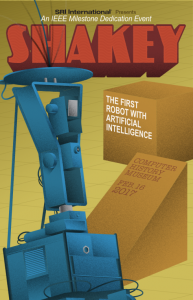IEEE Milestone: Shakey, First Mobile Intelligent Robot
Milestone: Shakey, the World’s First Mobile Intelligent Robot, 1972
Dedication Date: February 16, 2017
This event is being held to dedicate an IEEE Milestone honoring Shakey’s impact on the world. The IEEE Milestone program honors significant technical achievements in areas related to electrical engineering and computing. Over 170 milestones have been dedicated since 1977, including five that were dedicated at the Computer History Museum: the Planar Process/Integrated Circuit, Inception of the ARPANET, SPICE, EEPROM/Flash Memory and now Shakey.A bronze plaque with a citation describing Shakey and its impact on the world will be unveiled at the conclusion of the event. The plaque will be installed at SRI International in Menlo Park, where Shakey was developed from 1966-1972. A second plaque will be installed at the Computer History Museum. A detailed description of Shakey including the plaque’s citation is available on the IEEE Milestone website which includes this fascinating 16mm movie of Shakey in action many years ago.
 |
This special event at the Computer History Museum will honor Shakey the Robot. The program will include on-stage interviews by Pulitzer Prize winner John Markoff of Drs. Peter Hart and Nils Nilsson, who led the creation of Shakey at SRI International in 1966-72. John will then explore Shakey’s legacy with roboticist Dr. Steve Cousins of Savioke, Dr. William Mark of SRI and Mars Rover Driver Matt Heverly of JPL-NASA. The program will be officiated by IEEE President Elect Jim Jefferies and IEEE Region 6 Milestone Coordinator Brian Berg.Shakey was the world’s first robot to embody artificial intelligence. It could perceive its surroundings, logically deduce implicit facts from explicit ones, navigate from place to place, make a plan to achieve a goal, monitor the execution of a plan in the real world, recover from errors in plan execution, improve its planning abilities through learning, and communicate in simple English.
Although Shakey’s 50-year old hardware design and computational resources are primitive by today’s standards, its software architecture and algorithms created a legacy that influences more than just the design of today’s robots. When your phone computes driving directions, when your car warns that you’re veering out of your lane, when a character moves in a video game, and when the Curiosity Rover autonomously navigates obstacles on the Martian surface – techniques first developed for Shakey are being used. |
Agenda
CITATION
Stanford Research Institute’s Artificial Intelligence Center developed the world’s first mobile intelligent robot, Shakey. It could perceive its surroundings, infer implicit facts from explicit ones, create plans, recover from errors in plan execution, and communicate using ordinary English. Shakey’s software architecture, computer vision, and methods for navigation and planning proved seminal in robotics and in the design of web servers, automobiles, factories, video games and Mars rovers.
For more information see Milestone page.
______________________________________________
Computer History Museum
1401 N. Shoreline Blvd
Mountain View, CA 94043
